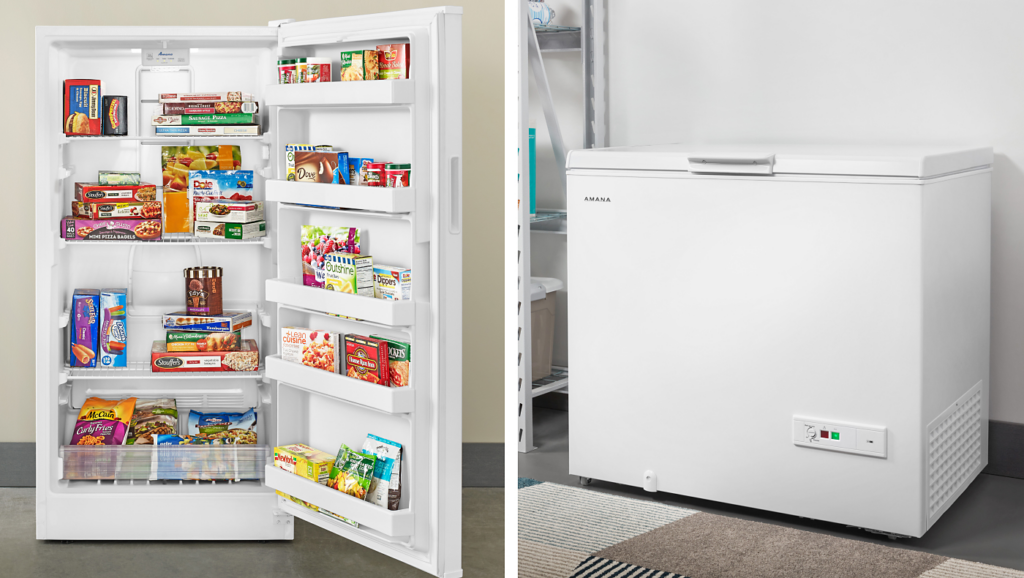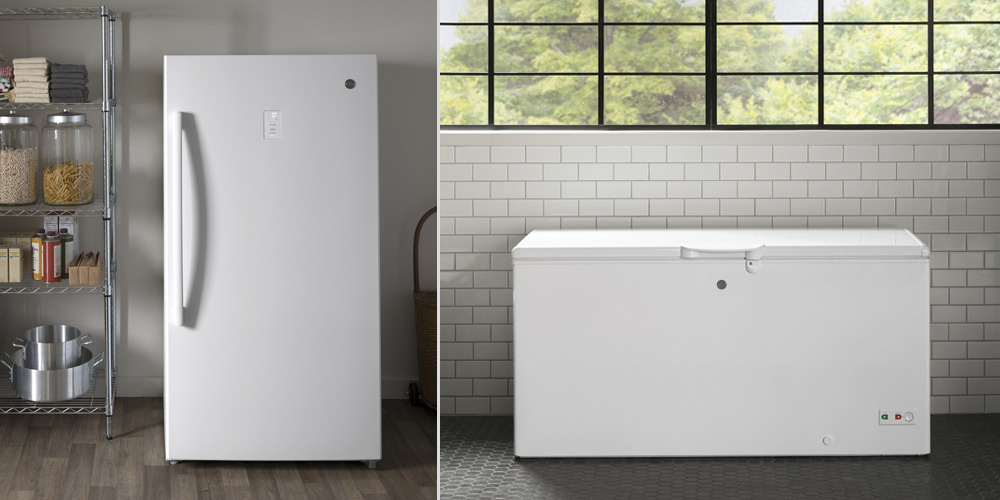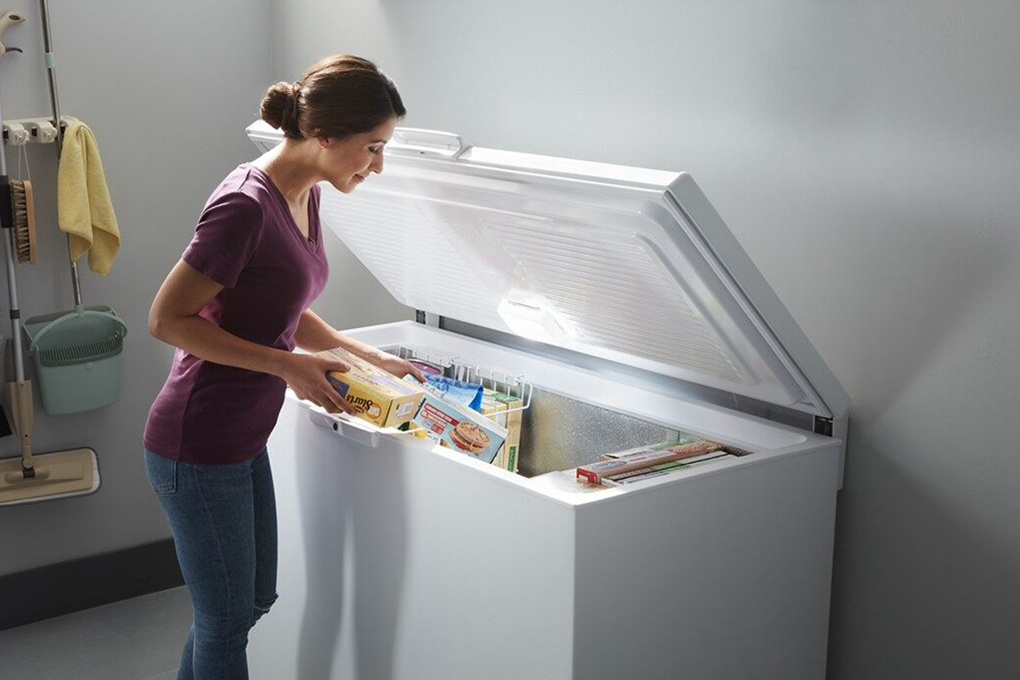A chest freezer is a type of household appliance designed for long-term food storage at low temperatures. Unlike upright freezers, which have a vertical design and shelves, chest freezers have a horizontal, chest-like configuration. They are typically used to store frozen foods, bulk items, and items that you want to keep frozen for an extended period.
Choosing the right chest freezer for your needs involves considering several factors to ensure you get the best one for your home or business. Let us discuss some of the chest freezer types, their main usage and several other characteristics of a chest freezer.
Types of Chest Freezers Available

Source: amana.com
When choosing a chest freezer to purchase, make sure to consider the type that best suits your storage needs, which may differ from one individual to another depending on their requirements. Each type has its advantages and limitations, so you may select the one that matches your preferences and usage scenarios. Here are some of the main chest freezers you may come across.
-
Standard Chest Freezer:
These are the most common types of chest freezers.
They have a simple design with a hinged lid that opens from the top.
Standard chest freezers are available in various sizes and capacities to suit different storage needs.
-
Frost-Free Chest Freezer:
Frost-free chest freezers automatically defrost themselves, preventing ice buildup.
This type of freezer is convenient because you don’t need to defrost it manually.
However, they may use slightly more energy compared to manual defrost models.
-
Compact or Small Chest Freezer:
Compact chest freezers are designed for small spaces, such as apartments or dorm rooms.
They have a smaller storage capacity but are still capable of keeping food frozen.
-
Commercial Chest Freezer:
Commercial chest freezers are designed for use in businesses like restaurants, supermarkets, or food service establishments.
They are typically larger and much stronger, with features like heavy-duty construction and enhanced temperature control.
-
Convertible Chest Freezer:
Some chest freezers come with a convertible feature that allows you to switch between freezer and refrigerator modes, which allows dual usage.
This flexibility can be useful if you need additional refrigeration space at times.
-
Energy-Efficient Chest Freezer:
Energy-efficient chest freezers are designed to consume less electricity, helping you save on energy costs.
Look for ENERGY STAR-rated models, which meet specific energy efficiency standards.
-
Dual-Zone Chest Freezer:
Dual-zone chest freezers have separate compartments with different temperature settings.
This type is handy if you need to store items at two different temperatures, such as freezing and chilling.
-
Retro or Vintage Chest Freezer:
Retro or vintage-style chest freezers are designed to have a nostalgic appearance, often resembling older appliances.
They can add a unique aesthetic to your kitchen or living space.
-
Specialty Chest Freezer:
Some chest freezers are designed for specific purposes, such as storing vaccines or medical supplies at ultra-low temperatures.
These speciality freezers may have precise temperature control and additional safety features.
-
Mobile or Portable Chest Freezer:
Mobile or portable chest freezers are designed for on-the-go use, such as camping or road trips.
They may operate on alternative power sources like DC car adapters.
Usages of a Chest Freezer

Source: abt.com
A chest freezer is a flexible appliance that offers various uses and benefits in residential and commercial settings. Here are some common usages of chest freezers:
Food Storage: Frozen Foods: The primary use of chest freezers is to store frozen foods for extended periods. They are ideal for preserving meats, vegetables, fruits, and prepared meals.
Meal Prep and Batch Cooking: Chest freezers enable you to prepare and store large batches of homemade meals, saving time and effort on future cooking.
Long-Term Food Preservation: They are suitable for long-term food preservation, allowing you to store seasonal produce, homemade jams, and other items for months or even years.
Commercial Food Storage: In restaurants and food service establishments, chest freezers are used to store bulk ingredients, frozen goods, and prepared dishes.
Ice Cream Storage: Chest freezers are popular choices for storing ice cream because they can maintain extremely low temperatures necessary to keep ice cream firm and fresh.
Home Gardeners: Gardeners can store surplus produce from their gardens, including fruits, vegetables, and herbs, to enjoy the harvest year-round.
Pharmaceutical Storage: Some chest freezers are used in medical and research settings to store vaccines, medications, and biological samples at ultra-low temperatures.
Storage of Specialty Items: Chest freezers can store special items such as breast milk, ice sculptures, or laboratory specimens.
Wine and Beverage Storage: Some people convert chest freezers into temperature-controlled wine or beverage coolers by adding racks and temperature-control units.
The versatility and efficiency of chest freezers make them useful appliances for households and businesses, allowing convenient, long-term storage, minimising food wastage and ensuring food safety.
Factors to Consider Before Purchasing a Chest Freezer

Source: qualifiedremodeler.com
Before purchasing a chest freezer, several essential factors should be considered. First, measure the available space where you intend to place the freezer and assess your storage needs to determine the appropriate size and capacity. Energy efficiency is another crucial factor, as an energy-efficient chest freezer can help you save on electricity bills over time; look for ENERGY STAR-rated models when purchasing your chest freezer. Also, ensure the freezer can reach and maintain the necessary low temperatures for long-term food storage, typically between -10°F to -20°F or -23°C to -29°C. Decide between manual defrost and frost-free models, with the latter being more convenient but potentially consuming more energy. Consider interior features such as removable baskets and dividers for better organization. Evaluate access options, and noise levels, through customer reviews. Don’t forget to check the warranty and set a budget that aligns with your preferences. Taking these factors into account will help you select the ideal chest freezer for your needs.
Conclusion
In summary, a chest freezer is a valuable addition to your home or business, offering ample storage and long-term food preservation. This guide has covered types, key factors to consider, and how to choose the right one. With proper selection and maintenance, a chest freezer can reduce food waste and provide convenience, making it a smart investment for all your frozen storage needs.



